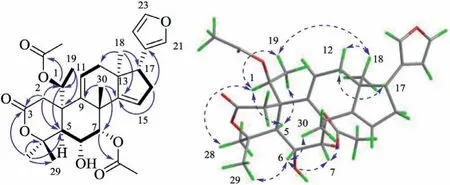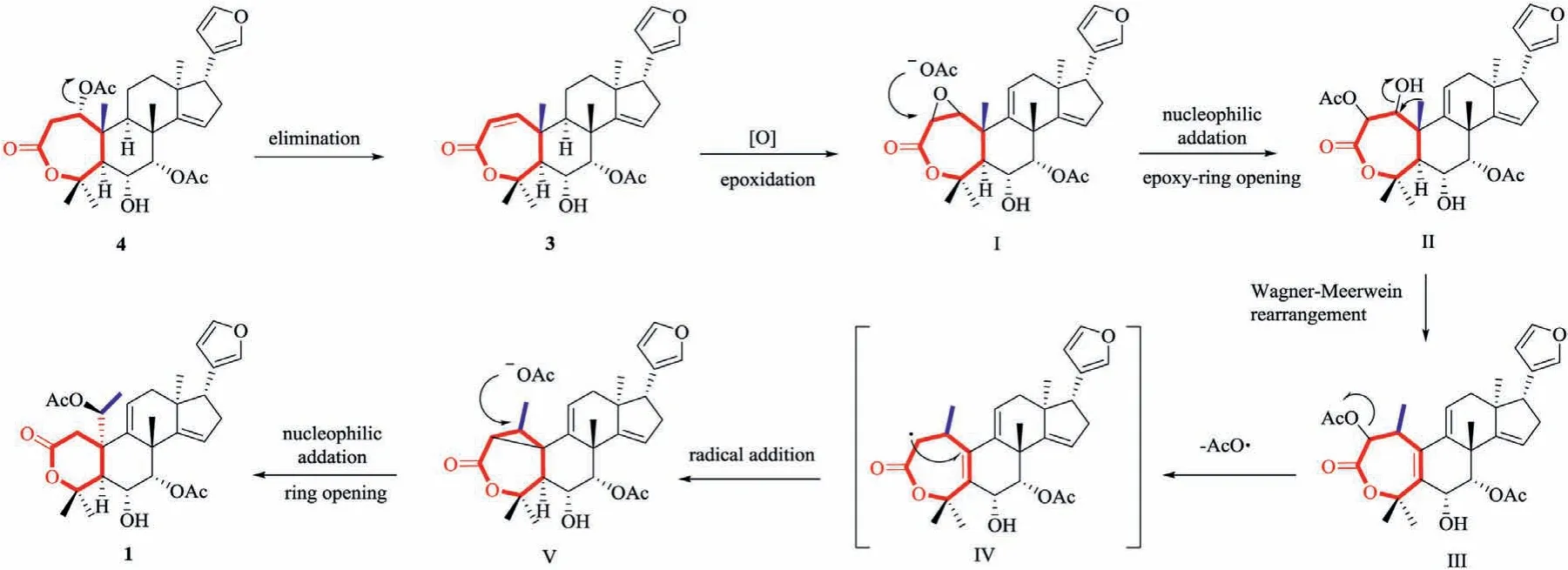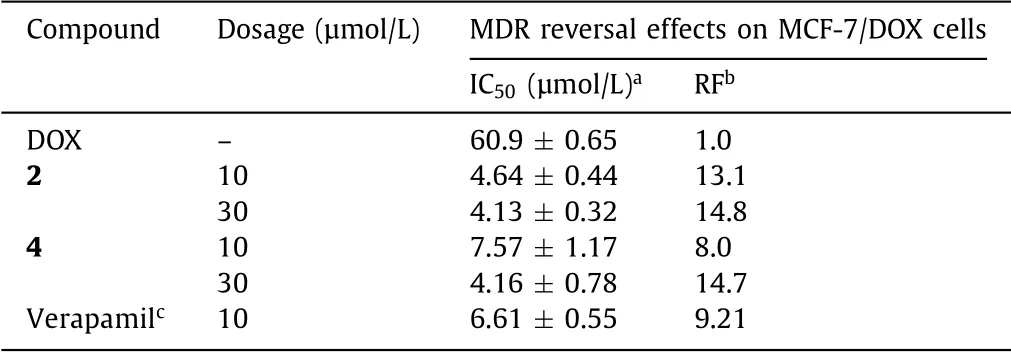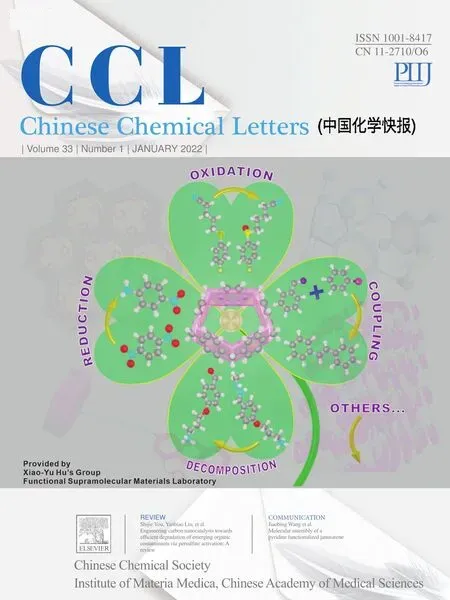Mufolinin A,an unprecedented ring A-seco 10-ethyllimonoid from Munronia unifoliolata
Yunpeng Sun,Letian Cui,Qiurong Li,Pengfei Tang,Yongyi Li,Wenjun Xu,Jun Luo,Lingyi Kong
Jiangsu Key Laboratory of Bioactive Natural Product Research and State Key Laboratory of Natural Medicines,School of Traditional Chinese Pharmacy,China Pharmaceutical University,Nanjing 210009,China
ABSTRACT Mufolinin A(1),a ring A-seco rearranged limonoid with an unprecedented ethyl at C-10 and novel 6/6/6/5 fused-ring skeleton,together with three new potential precursors(ring A-seco limonoids,2–4)were isolated from Munronia unifoliolata.Their structures and absolute configurations were confirmed by nuclear magnetic resonance(NMR),high resolution electrospray ionization mass spectroscopy(HRESIMS),X-ray crystallography,electronic circular dichroism(ECD)calculations and NMR calculations with DP4+ analyses.The unprecedented ethyl group of 1 was hypothesized to be derived from methyl migration and ring reduction rearrangement of ring A-seco limonoid 4.Compounds 2 and 4 showed significant multidrug resistance(MDR)reversal activities in MCF-7/DOX cells with reversal fold(RF)values of 13.1 and 8.0,respectively.
Keywords:Meliaceae Munronia unifoliolata Limonoids Anti-inflammatory Anti-multidrug resistance
Limonoids are a class of natural products with diverse skeleton types and a wide spectrum of biological activities,widely distributed in the plants of Meliaceae and Rutaceae.Simple ringintact limonoids with 17β-furan ring are formed by loss of fourterminal carbons of the side chain in the apotirucallane or apoeuphane skeleton[1].Under the action of the enzyme,the ringintact limonoids with tetracyclic skeleton can undergo oxidation and ring opening to form a variety of ring-secolimonoids[2].Further oxidative rearrangement allows diverse structure types of limonoids to be possible[3].In previous studies,we reported several kinds of novel limonoid skeletons with ring cleavage and carbon skeleton rearrangement[4].To our knowledge,the formation of a novel limonoid skeletonviamethyl migration is very rare,only one 18(13→14)-abeo-limonoid skeleton has been reported[5].
The plants fromMunroniagenus(Meliaceae)are dwarf shrubs or semi shrubs,and some of them have been used as traditional Chinese medicine(“Aituotuo” in Chinese)for treatment of bruises,rheumatic joint pains,coughs,stomach-aches,tuberculosis and sores[6].In recent years,more than 60 ring-intact and ring-secolimonoids with significant anti-inflammatory,antimicrobial and anti-tobacco mosaic virus(TMV)biological activities have been isolated from “Aituotuo”[7].M.unifoliolata,one of the resources of “Aituotuo”,is widely distributed in the southwest of China and also contains abundant limonoids[8].In this research,an A-ring rearranged limonoid with an unprecedented ethyl at C-10 and novel 6/6/6/5 fused-ring skeleton,mufolinin A(1),together with three new potential precursors(ring A-secolimonoids,2–4)(Fig.1)were isolated from the whole plant ofM.unifoliolata.Their structures were elucidated on the basis of extensive one dimension(1D)and two dimension nuclear magnetic resonance(2D NMR)experiments,X-ray crystallographic method,electronic circular dichroism(ECD)calculations and NMR calculations with DP4+analyses.Based on the traditional medicinal efficacy ofM.unifoliolata,bioactivities including anti-inflammatory and anti-MDR activities of compounds 1–4 were also tested.Herein,the details of the isolation,structure elucidation,biosynthetic relationship and bioactivities of mufolinins A–D(1–4)were described.
Mufolinin A(1)was obtained as white amorphous powder.Its high resolution electrospray ionization mass spectroscopy(HRESIMS)displayed a quasi-molecular ion peak atm/z549.2457[M + Na]+,corresponding to the molecular formula C30H38O8with 12 degrees of unsaturation.The1H and13C NMR spectra(Table S1.1 in Supporting information)indicated that 1 was a ring A-secolimonoid,and its B,C and D rings withΔ9,11andΔ14,15double bonds were readily established by comparison with those of several known limonoids[8]and key heteronuclear multiple bond correlations(HMBCs)(Fig.2).Surprisingly,the1H NMR spectrum(Fig.S4.1.1 in Supporting information)exhibited a secondary methyl group(δH1.35),which showed1H–1H coupling correlation spectroscopy(COSY)correlation to H-1(δH4.97)and the HMBC crosspeaks to C-1(δC76.0)and C-10(δC46.1).These data indicated that an acetyl-substituted ethyl group was connected to C-10,which was also confirmed by the HMBC correlations from H-1 to C-9(δC138.9),C-10(δC46.1),C-2(δC42.3),C-5(δC47.8)and a carbonyl carbon(δC170.1).Meanwhile,the heptonolactone ring in the general ring A-secolimonoids was reduced into a hexonolactone ring in 1,which was further confirmed by the HMBC correlations from H-2(δH2.79 and 2.64)to C-3(δC171.0),C-5,and from H3-28(δH1.62)to C-3.Thus,the unprecedented C-10 ethyl and novel 6/6/6/5 fused-ring skeleton of 1 were assigned.

Fig.1.Structures of compounds 1–4.

Fig.2..
The relative configuration of 1 was established by analysis of its rotating-frame overhauser spectroscopy(ROESY)spectrum(Fig.2).The ROESY correlations of H3-19 and H-1 to H-5 suggested a same orientation of these protons which were assigned to beα-oriented.Meanwhile,the correlations of H3-19/H3-18/H-12(δH2.40)and H-1/H3-28 determined the spatial orientation of the ethyl group.Theβ-orientation of H-6,H-7,H-17,H3-29 and H3-30 were confirmed by the ROESY correlations of H3-30/H-7/H-6/H3-29,and H-17/H-12(δH2.11)(Fig.S4.1.6 in Supporting information).To determine the configuration of C-1,the13C chemical shifts of two tentative C-1 epimers(1R)-1 and(1S)-1 were calculated by the density functional theory(DFT)gage independent atomic orbital(GIAO)method at the mPW1PW91/6–311+G(d,p)theory level(Fig.S1.1 in Supporting information)[9].Further DP4+ analyses based on both1H and13C NMR data indicated(1S)-1 as the correct structure with 100% probability[10].Finally,the absolute configuration of 1(1S,5S,6R,7S,8S,10S,17R)was confirmed by comparing the experimental and calculated ECD data with time-dependent density functional theory(TD-DFT)(Fig.S1.3 in Supporting information).Hence,the novel structure of 1 was depicted as shown in Fig.1.
The 1D NMR data(Table S1.1 in Supporting information)of mufolinins B(2)and C(3)showed characteristic signals of aβsubstituted furan ring,anα,β-unsaturated lactone group,and at least one acetoxy substituent in each compound,making them structurally similar to munronoid D[8a],a ring A-secolimonoid with a 3,4-lactone.Compared 2 with munronoid D,the only difference was aβ-substituted furan ring group(δH7.37,7.23,6.26;δC142.8,139.9,111.1,124.4)at C-17 in 2 instead of aγ-lactone ring.The relative configuration of 2 was corroborated by the ROESY spectrum(Fig.S4.2.6 in Supporting information),in which the correlations of H-6/H-7/H3-30 and H-17/H-12(δH1.77)revealed that these protons were on the same side asβ-orientation.The ROESY cross-peaks of H-5/H-9/H3-18/H-12(δH1.85)indicated that H-5,H-9,H3-18 and H-12(δH1.85)wereα-oriented(Fig.S1.4 in Supporting information).Mufolinin C(3)gave a molecular formula of C28H36O6,as determined from its HRESIMS ion atm/z491.2406[M + Na]+(calcd.491.2404),which exhibited 42 daltons less than that of 2.In NMR spectroscopic data of 3 and 2,the observed significant upfield shifts of H-6(δH4.28,Δδ−1.03)and C-6(δC67.6,Δδ−2.4)indicated replacement of the acetoxy group at C-6 in 2 by a hydroxy group in 3.Based on 1D NMR data and ROESY correlations,the relative configuration of 3 was assigned to be the same as that of 2(Fig.S1.4 in Supporting information).Therefore,the structures of 2 and 3 were established as shown in Fig.1.
Mufolinin D(4)was obtained as colorless crystals.It was assigned the molecular formula of C30H40O8,as established by HRESIMS.The 1D NMR data(Table S1.1 in Supporting information)of 4 showed many similarities to those of 3,with the main differences in the absence of aΔ1,2double bond and the presence of an acetoxy group in 4.The above changes were established by analysis of HMBC correlations from H-1(δH4.86)to C-5(δC48.3),Me-19(δC17.4)and the acetoxy carbonyl(δC169.1),and the1H–1H COSY cross-peak of H-1/H-2(δH2.64,2.96)in 4(Fig.S1.4 in Supporting information).The relative configuration of 1-OAc was assigned asα-oriented by the ROESY correlations of H-1/H3-19 and H-1/H3-30.Moreover,a single-crystal X-ray diffraction experiment(Fig.S1.5 in Supporting information)allowed the full assignment of the absolute configuration of 4(1S,5S,6R,7S,8R,9R,10R,13S,17R)[Flack parameter=0.05(6);CCDC 2013523].
The hypothetical biosynthetic pathway of 1 was illustrated in Scheme 1.Abundant ring A-secolimonoids,such as mufolinin D(4)isolated,were considered to be the precursor.Compound 4 was deacetylated to give 3 withΔ1,2double bond and then oxidized continuously to obtain 1,2 epoxide I with double bond C-9/11 under the action of the enzyme.Subsequently,nucleophilic attack from AcO−to 1,2-epoxy formed the intermediate II.The hydroxy group left under acidic conditions to form a carbocation,triggering Wagner-Meerwein rearrangement.As a result,Me-19 migrated to C-1,and a rearranged carbocation(C-10)was generated.Subsequently,the loss of a proton delivered the double bond C-5/10[5a].The acetoxy group at theorthoposition of the ester carbonyl group led to the formation of a free radical[11],which then reacted with the double bond in the ring and produced a three-membered ring.Finally,under the nucleophilic attack of AcO−,the three-membered ring with high tension underwent ring opening process to afford compound 1.

Scheme 1.Hypothetical biosynthetic pathway of mufolinin A(1).
Mufolinins A–D(1–4)were tested for their inhibitory effects on nitric oxide(NO)production in lipopolysaccharide(LPS)-stimulated RAW264.7 macrophage cells[12]and the reversal activities of multidrug resistance(MDR)in MCF-7/DOX cells.Compound 2 exhibited moderate anti-inflammatory activity with the half maximal inhibitory concentration(IC50)value of 31.2 μmol/L(NGmonomethyl-L-arginine monoacetate was used as a positive control with the IC50value of 44.4 μmol/L).Moreover,2 and 4 at the concentration of 10 μmol/L showed significant MDR reversal effects on MCF-7/DOX cells subjected to doxorubicin(DOX),of which compound 2 was even better than the positive drug verapamil(Table 1).

Table 1 In vitro MDR reversal activity and cytotoxicity of compounds 2 and 4.
In conclusion,mufolinin A(1),the first example of ring A rearranged limonoid with unprecedented ethyl at C-10 and novel 6/6/6/5 fused-ring skeleton,was isolated fromM.unifoliolata,together with three possible biosynthetic precursors mufolinins B–D(2–4).This is the first report of limonoid undergoing methyl migration and ring reduction rearrangement.In addition,compounds 2 and 4 showed significant multidrug resistance(MDR)reversal activities in MCF-7/DOX cells,which was similar to or even better than the positive control verapamil at the same dosage.This research provided a reference for the study of novel limonoids and their pharmacological activities fromM.unifoliolata.
Declaration of competing interest
The authors declare that they have no known competing financial interests or personal relationships that could have appeared to influence the work reported in this paper.
Acknowledgments
This work was supported by the National Natural Science Foundation of China(No.31470416),the 111 Project from Ministry of Education of China and the State Administration of Foreign Export Affairs of China(No.B18056).Computational resources used in this work were supported in part by SciGrid,Chinese Academy of Sciences.
Appendix A.Supplementary data
Supplementary material associated with this article can be found,in the online version,at doi:10.1016/j.cclet.2021.06.050.
 Chinese Chemical Letters2022年1期
Chinese Chemical Letters2022年1期
- Chinese Chemical Letters的其它文章
- Engineering carbon nanocatalysts towards efficient degradation of emerging organic contaminants via persulfate activation:A review
- Recent advances in nanoscale metal-organic frameworks biosensors for detection of biomarkers
- Porphyrin-based heterogeneous photocatalysts for solar energy conversion
- Systematic evaluation of advance in application and discharge mechanism of solution electrode glow discharge
- Insoluble carbonaceous materials as electron shuttles enhance the anaerobic/anoxic bioremediation of redox pollutants:Recent advances
- Selective N-terminal modification of peptides and proteins:Recent progresses and applications
